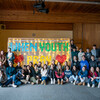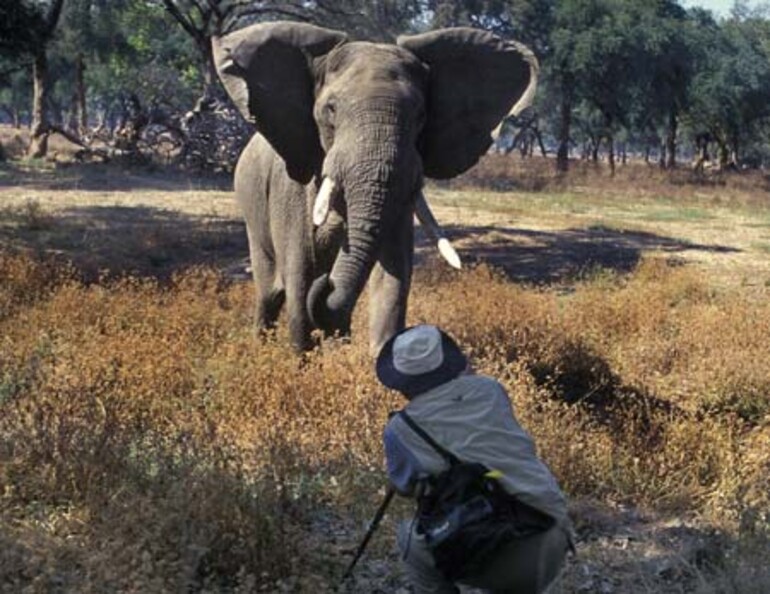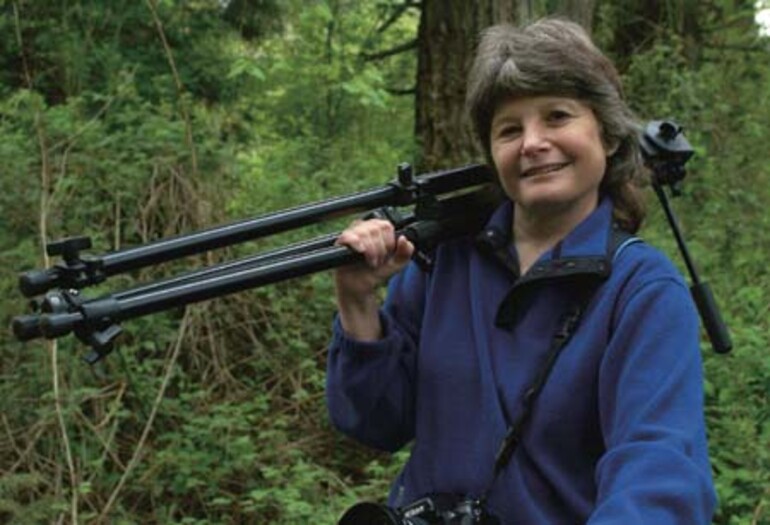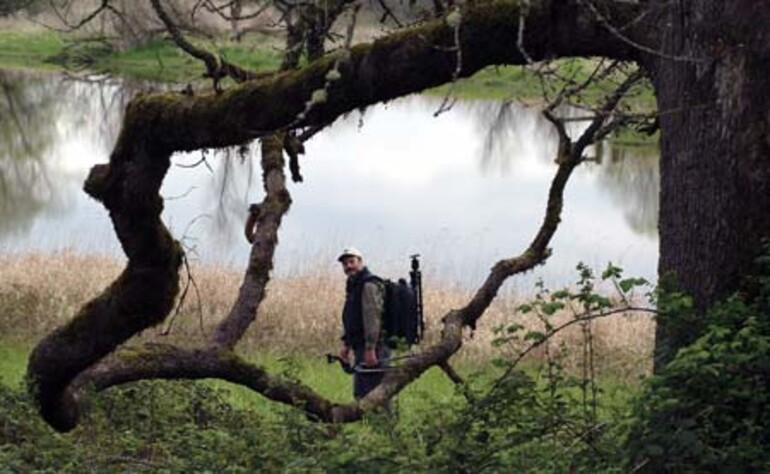How do you stop a charging bull elephant? The answer? Take away his credit card. Tom Leeson, a well-known Northwestern wildlife photographer has another answer and a story to tell.
“A friend and I were in Zimbabwe photographing two bull elephants eating acacia pods in the forest. I was kneeling on the ground about 25 yards ahead of the others taking pictures, when all of the sudden one of the big bulls saw me and charged with ears flapping. Our guide, who knew elephant behavior, walked up behind me and said, ‘Keep shooting, keep shooting,’ but I was ready to run!
“The elephants compete with baboons for the acacia pods and when they charge, the baboons always run. The elephant probably thought I was a baboon and would run when he charged. The guide knew this was a bluff and told me to keep shooting. I held still, and the elephant stopped about 10 feet away, looked me over, and went back to eating. Ultimately he took a pod about 18 inches from me.
“A little later we were photographing a cow-calf herd of elephants. This time the guide said, ‘If they get our scent we’re in trouble.’ Soon the trunks of the adults went up smelling the air and the guide took off running, and so did we. Looking back, we saw the entire herd stomping around, looking for us where we had just been.”
Becoming an internationally respected wildlife photography team was a long and difficult journey for Tom and his wife Pat. Lifelong Adventists, both Tom and Pat graduated from Columbia Adventist Academy in Battle Ground, Washington. Tom attended several colleges and ended up at Walla Walla College where he again met and eventually married Pat, a speech pathology major.
Tom tended to be a loner, preferring the outdoor life in which he had been raised. A product of the ’60s and ’70s, status didn’t mean much to him, and he did not want to live an average life with a house and garage full of things.
Stresses built up in their early marriage to the point that they separated and were heading for a divorce. “But Tom thought divorce was an ‘average’ way to settle things and figured that we needed to get away and learn to work together,” Pat recalls with a smile. So with $300 in their pockets, they packed their Volkswagen bug and took off for Gardner, Montana, near Yellowstone National Park, to become a husband/wife, writer/photographer team.
They finally located a small, non-winterized cabin to rent in nearby Cook City. “We spent the winter hauling wood and water just to survive,” Pat said. As stringers for The Livingston Enterprise newspaper, they earned $5 per picture. The newspaper wanted just one picture a week, but that paid their rent.
During that year, they decided to invite God to become a part of their team and business. They had taken for granted the Christianity they grew up with, and when faced with real issues, they found they had to establish their own relationship with Him.
Tom developed his understanding of the wildlife photography market through his love of the outdoors and his lifelong interest in wildlife. He and Pat read nature magazines and examined the best pictures being published.
“We compared our material to the best and worked to improve our techniques and vision,” Pat says. “Tom would say, ‘How can we kick this up a notch? Let’s problem solve here, let’s figure out what we can do to picture this subject better.’ He knew what Field and Stream wanted and what Audubon would buy. He knew what kind of pictures and what techniques to use for various markets.”
They started their wildlife photography career in Yellowstone, then moved to Port Angeles, Washington. Each day they got up early, drove up to Hurricane Ridge to shoot, then Pat would go to her part-time job at Payless. Later Tom would meet her in the parking lot, and they would again go shooting in the late afternoon.
Since they did not have money to travel, they would go back to the same places and take pictures of the same animals over and over, creating their unique style of photography. They documented the life cycle of black bear, grouse and most of the animals in the Northwest and North America. God blessed the fact that they did not have money, which forced them to create their style of working in-depth. That’s still how they do their best work—staying in a place long enough to capture it thoroughly.
During the next four years they made just enough money to keep them going but never enough to really get them on the road to success. Then in the late 1980s and into the middle ’90s, the nature photography market boomed, and their business took off. During those lean years, they bought only what they could eat or put in the camera, but now they have prospered and can travel to photograph the wildlife that the market demands. Ten years from the time they moved to Montana, Tom and Pat were again in Cook City, on an assignment for National Geographic, and they were able to stay in the lodge instead of their first little cabin.
Tom and Pat have photographed on every continent but Australia. Pat has traveled to India and has been in Africa three times. Tom photographed pandas in China and sailed on a Russian icebreaker in Antarctica.
Now, with their daughter Laura in school, and since someone needs to be in the office, one stays home while the other goes on assignment. Tom handles the more physical assignments and ones requiring the long, heavy lenses. Pat travels to some shoots, loves the underwater work and has photographed humpback and sperm whales and dolphins.
Their photographs appear in hundreds of U.S. and foreign publications each year including the magazines of the National Geographic Society, National Wildlife Federation, National Audubon Society and the Sierra Club. Their work has also appeared in the Reader’s Digest, Time, Life, The Wall Street Journal, Geo and other national magazines, as well as on the tails of Frontier airliners. A limited edition of their book, The American Eagle, was a presidential gift of state when George H.W. Bush presented a copy to England’s Queen Elizabeth in 1991.
Tom and Pat are finishing their current book America’s National Wildlife Refuges to be released this September as a celebration of the National Wildlife Refuge system centennial.
Pat says that when the book is complete, they don’t have a clue about what to do next. “Over the long haul, we have discovered how God has led in our lives and business. Somehow we have been directed into projects even though we didn’t know it at the time. When the time comes, we pray about it, and make a decision that might be right or wrong. Later we find out it was exactly right.”
Tom remains confident of God’s leading. “We are in this soft market right now, but we do have the confidence of knowing that God will meet our needs,” he said. “That’s our real security at this time when the market is not there.”
Tom and Pat love the outdoors and the wildlife they photograph. They hope that people will appreciate these beautiful wild animals as much as they do. Pat says, “If you don’t know something, you can’t love it. If you don’t love it, you’re not going to save it.” Through their images, Tom and Pat hope to encourage others to be stewards of the Earth and its inhabitants. •
Richard Dower edits the GLEANER and writes from Vancouver, Washington.















